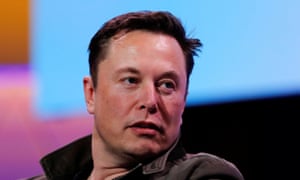Be wary of Elon Musk despoiling the ‘vault of heaven’
It’s feasible to flood space with flotillas of small satellites – but do we really want to?

Changing economics and advancing miniaturisation now enable flotillas of small satellites to be launched into space – up to a hundred on a single rocket. These microsatellites are already being deployed, by companies such as Planet Lab in California, to survey every point on the Earth every day, with sharp enough images to study building sites, road traffic, land use and so forth.
But a bigger leap is now in the offing. Elon Musk’s company SpaceX envisages the “Starlink” project. This entails launching up to 40,000 spacecraft into orbit in order to create a network that will enhance global broadband communication. Other companies, such as Amazon, say they have similar plans.
In principle, these are exciting and welcome developments, especially if they bring broadband internet to the whole of Africa and other parts of the developing world. But there is a downside. Starlink would involve launching more objects into space, in this single constellation, than all the satellites launched in the 60 years since the birth of the space age. There would be roughly one in every square degree over the sky (the area on the sky covered by a small coin held at arm’s length).
Skywatchers could find that their familiar starry sky was augmented by huge numbers of bright spots moving across it, especially soon after sunset and just before sunrise (the periods in the day when the sun is below our horizon but shining on to satellites hundreds of kilometres above us.) For professional astronomers looking steadily at a single celestial body, these rogue lights would only be a minor irritant. However, they would cause more confusion to projects that monitor or search large areas of sky to seek transient objects – exploding stars or even more exotic cosmic explosions. Especially confusing will be the cases when part of the satellite acts like a mirror, creating a specially bright and brief flash when it’s oriented so that it reflects the sun.
One particularly important project that could be impeded by these swarms of satellites is the search for asteroids. There are 2m asteroids, which are more than 50 metres across, whose orbits cross that of the Earth. Any of these could potentially hit Earth and would be big enough for its impact to destroy a large city. Even though most of the giant (dinosaur-killing) asteroids more than 1km across have been discovered, only 2% of these still dangerous smaller ones are known and there’s a strong motive to search for all the others, so that those with trajectories that could bring them dangerously close to our world can be deflected well in advance. In such searches, the “foreground” of unpredictably moving satellites would be a complication.
There are also concerns among astronomers making measurements in the microwave bands – trying to discover and understand young stars, protoplanets and such like, as well as their constituent gases and molecules. Such observations will be impeded if Starlink satellites’ uplinks or downlinks “pollute” observationally interesting wavebands.
Radio telescopes are constructed in “radio quiet” places to minimise artificial background, but there would be no hiding from the beams sent from these satellites.
In mitigation, this particular enterprise is motivated by a goal that we should acclaim: spreading the genuine benefit of broadband worldwide, especially to the developing world. And it’s a plus that the mega companies involved are genuinely aware of the downsides and will be doing all they can to minimise it by blackening the surfaces and choosing wavelengths carefully. These ventures are not as irresponsible as earlier (and fortunately quashed) proposals to build large advertising hoardings in space.
But we shouldn’t forget that it’s not just astronomers – a minority – who care about this issue. The night sky, the “vault of heaven”, is the one feature of our environment that has been shared, and wondered at, by all humanity through the ages. We should deplore anything that needlessly degrades its beauty and serenity, just as, more parochially, we don’t want tinsel or phone masts in our national parks.
• Martin Rees is the astronomer royal. His latest book is On the Future: Prospects for Humanity.”



:max_bytes(150000):strip_icc():format(webp)/charging-phones-169245284-resized-56a62b735f9b58b7d0e04592.jpg)





